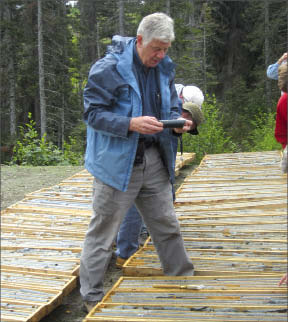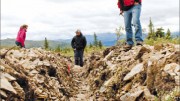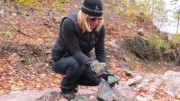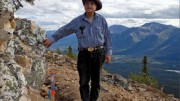For a base metals junior, First Point Minerals (FPX-V) looks to have it all.
The company has a greenfield nickel-iron discovery of potentially huge proportions in its flagship Decar project located in a mining-friendly portion of central B.C.
It also has a world-class joint-venture partner in Cliffs Natural Resources (CLF-N), which can earn a 75% interest in the project byfunding and serving as operator on exploration and engineering studies until a feasibility study is complete.
The Decar project’s bulk-tonnage, open-pittable potential resource has had excellent recovery in advanced metallurgical testwork, using only basic grinding, gravity and magnetic-separation processing methods.
Tailings from the mine would also be acid-free, which could result in less environmental resistance. And the concentrate produced would be free of sulphur and so bypass costly smelters on its way to market, with the project lying just 5 km away from a rail line and 110 km from a power grid.
The mineral the partners want to mine is called “awaruite.”
Most geologists and lay people cannot even pronounce it, let alone know its uses. As Ron Britten, First Point’s vice-president of exploration, explains during a visit to the property: “We talked to a lot of nickel players two and a half years ago when we were trying to get a partner for Decar, and even the best geologists working in nickel didn’t know about awaruite . . . Finally, a Kiwi – actually my old boss at Homestake Mining – came to the Prospectors and Developers Association of Canada convention when I was showing off the stuff. And he said, ‘No, Ron. You don’t pronounce it that way. It’s like this: “ah-where-oo-ite.” You’ve got to pronounce the “u” in the middle.’ “
A nickel-iron alloy First Point likes to call “naturally occurring stainless steel,” awaruite is heavy and magnetic, comprising 75% nickel, 25% iron and 0% sulphur. It is widely disseminated at the 132-sq.-km Decar project, where the average grade of awaruite in the serpentinized ultramafic host rocks ranges from 0.1% to 0.15%.
Occurring as tiny white grains ranging from 5 microns to 400 microns in width – 400 microns is 0.4 of a millimetre – metallurgical tests have shown 80% of the awaruite grains are recoverable to produce a desirable ferronickel concentrate grading 2.6% nickel, 52% iron as magnetite and 2.2% chromite.
But with nickel prices hovering between US$9 and US$10 per lb., compared with a high of US$24 in early 2007, investors are a little more hard-pressed to think much about nickel, a major component in stainless steel. As for asking investors to rethink the concept of nickel mining altogether – well, that adds another challenge.
First Point has found a dynamic JV partner in Cliffs. The Cleveland-based major iron ore and coal producer has boosted its exploration expenditures on the project this year. It plans to spend over $7 million advancing the project in 2011, up from the US$1.8 million program it proposed at the start of the year and the US$1.4 million spent in 2010.
Cliffs has now more than fulfilled its US$4.5-million spending requirement over four years under the JV partners’ original option agreement.
Clifford Smith, Cliff’s senior vice-president of global business development, even said in an analyst and investor day presentation in June that the Decar project is “something we are very excited about. It’s going to be our first major discovery as we move forward.”
As Britten explains it, Cliffs “didn’t get the total metallurgical results back from our preliminary tests in the winter until late June, and that’s when they went, ‘Oh. Hmmm.’ Obviously, in-house they must have said, ‘We’ve got to fast track this sucker.'”
Cliffs has expanded this year’s drill program at Decar from 4,000 metres using one rig to 15,000 metres using four rigs. It plans to put 47 drill holes with downhole depths of 300 metres into the main Baptiste zone, where seven widely spaced holes were drilled this year. Fourteen of the holes have been completed so far, with assay results pending. One of those holes reached 600 metres to test the extent of mineralization at depth as well.
Three other targets at Decar may see drilling this year: four holes are planned on a ridgetop 3 km north of Baptiste called the Sidney zone, where two holes in 2010 intersected nickel-in-alloy mineralization to a downhole depth of 398 metres; two holes are planned for the never-before-drilled Van target, located 6.2 km north of Baptiste and measuring 1,150 metres long by 200 metres wide; and one hole has been completed at Target B, a prospective new zone 4.6 km north-northwest of Baptiste. The company expects to continue drilling at Decar until late in October, weather permitting.
Cliffs hopes to delineate a maiden inferred resource estimate at Baptiste by targeting a 2,500-
by-700-metre area using 200-metre centres.
“This is new stuff,” Britten says. “It’s really hard to know whether or not 200-metre-spaced drill holes are even going to give you a resource – that’s mainly going to be driven by geostats and 43-101 definitions. But with Decar being like a porphyry-copper system, I figure they should be able to do it with that kind of spacing, if they can show the mineralization is continuous.”
As an illustration, a 500-by-500-metre mineralized zone at Baptiste could result in a 300-million-tonne resource.
In mid-September, Cliffs hired an engineering consultant group to conduct a National Instrument 43-101-compliant preliminary economic assessment. Cliffs has agreed to complete the study in 18 months, though First Point is hopeful it will be finished in a year.
In the meantime, First Point is on the hunt for other Decars. “We’re doing a global search right now,” Britten explains. “But until we have mineral title, we won’t disclose anything.”
But First Point has let a few clues slip out. The company is exploring for awaruite in seven countries, including the U.S. and Canada, and has already found prospects for the mineral in central and northern B.C. It has staked seven large properties north of Decar, all 100% owned, four of which comprise a semi-continuous 130-km trend north of Decar. The other three are located west of Dease Lake in northern B.C. There is also the early-stage Joe property in Oregon.
The most advanced prospect of the bunch is Klow, a 950-by-270-metre drill-ready target 70 km north of Decar. First Point hopes to drill there later this year or in early 2012, once it has the necessary permits in place. Unlike Decar, some samples contain sulphides at Klow. How much, however, remains unclear.
“Our global search is ongoing, alive and busy,” Britten says. “I’m busier on that than anything else. Decar can take care of itself, I hope. I think you’ll hear some news in the next two or three months, once we’ve picked up the ground that we want.”
First Point is spending $2 million this year on worldwide exploration, with $350,000 of that on properties in B.C.
“If we can find two or three Decars . . . it will impact nickel. I shouldn’t say the price of nickel, but it will change the makeup of the industy. It is a game changer . . . because this style of mineralization will be much easier to produce than laterites. You don’t have to worry about energy costs, and energy costs are going to get higher and higher . . . we figure we can find more, we’re pretty confident of that. And we’re the only game in town – for now.”
But a lot of this depends on whether Decar moves from concept to reality, and that will require significantly more work.
Proving out recoverability is a major next step. Metallurgical testing so far has shown First Point can recover awaruite grains down to about 50 microns in size, but anything less than that the company is
not sure about.
Below 20 microns could be a problem, because the grains are hosted in non-magnetic serpentine minerals. They are lighter and might not get picked up by gravity separation.
For the most part, First Point has established that the distribution of awaruite at the main Baptiste zone is universal. There is no control in terms of local structural features.
There is also a loose relationship between grain size and higher nickel values, within a range between 0.1% to 0.15% nickel.
One concern is that if grain size drops in certain areas, and the smallest grains of awaruite cannot be recovered, it might lead to significant dilution in the mine plan.
Cliffs is now completing advanced metallurgical testwork in an effort to demonstrate this will not be the case.
Since awaruite has also never been mined before, Cliffs might want to build a full-scale pilot plant before building a first-of-its-kind mining operation. Though the mechanical processing method is standard, the mineral being mined is new.
Decar’s economics have also yet to be proven out, even in a preliminary scoping study.
Socially, there are ongoing First Nation issues at Decar that Cliffs and First Point must resolve.
The local Tl’azt’en Nation group issued a non-binding stop-work order to Cliffs in August after claiming the company had lied to them and insulted them by “hiring private security guards to keep us out of our lands.”
Cliffs is continuing its work on the property and has said it remains focused on resolving differences.
Tl’azt’en want a signed exploration agreement before any more work takes place.
First Point says the parties are working toward a deal but have yet to work out the details.
It appears the B.C. group has caught on to the tactics of its Ontario counterparts, who have tried with some success to disrupt Cliff’s exploration in the Ring of Fire area in order to force the company to make concessions.
As of June 30, First Point had $9 million cash in its treasury. It has 90.4 million shares outstanding and 102 million if fully diluted, with management and insiders controlling 5%.
As the company’s largest shareholder, Cliffs controls 13.6 million shares, or 15% of the company.
First Point’s shares closed at 67¢ on Sept. 22, within a 52-week range of 57¢-$1.06.






Be the first to comment on "First Point, Cliffs rev up Decar nickel-iron project in BC"